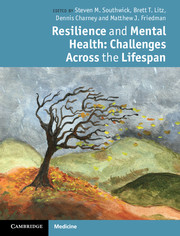Book contents
- Frontmatter
- Contents
- Contributors
- Preface
- Section 1 Pathways to resilience
- Section 2 Resilience across the lifespan
- Section 3 Resilience in families, communities, and societies
- Section 4 Specific challenges
- Section 5 Training for resilience
- 20 Interventions to enhance resilience and resilience-related constructs in adults
- 21 Childhood resilience: adaptation, mastery, and attachment
- 22 Military mental health training: building resilience
- 23 Public health practice and disaster resilience: a framework integrating resilience as a worker protection strategy
- Index
- References
23 - Public health practice and disaster resilience: a framework integrating resilience as a worker protection strategy
from Section 5 - Training for resilience
Published online by Cambridge University Press: 07 September 2011
- Frontmatter
- Contents
- Contributors
- Preface
- Section 1 Pathways to resilience
- Section 2 Resilience across the lifespan
- Section 3 Resilience in families, communities, and societies
- Section 4 Specific challenges
- Section 5 Training for resilience
- 20 Interventions to enhance resilience and resilience-related constructs in adults
- 21 Childhood resilience: adaptation, mastery, and attachment
- 22 Military mental health training: building resilience
- 23 Public health practice and disaster resilience: a framework integrating resilience as a worker protection strategy
- Index
- References
Summary
Introduction
The disciplines of emergency management and public health share objectives in hazard identification and the application of control or prevention strategies in the advent of disasters. This chapter defines resilience as it pertains to workers converging at a disaster site to perform response, recovery, or clean-up operations. A conceptual framework will be applied to disaster situations to highlight intervention avenues to preserve or enhance the resilience of the workers. Possible interventions include worker training and education, medical and emotional support services, disaster safety management, and alignment of organizational culture, policy, and procedures.
The disciplines of public health and emergency management
Public health is “the science and art of preventing disease, prolonging life and promoting health and efficiency through organized community effort” (Winslow, 1920). Epidemiology is the basic science of public health research, policy, and practice; which provides methods to study factors affecting the health and illness of populations (Institute of Medicine, 2002). Modern public health practice requires alliance among many disciplines and emotionally charged points of view, particularly when health and safety become challenged by disasters. Public health and emergency management share the objectives of identifying hazards and managing risk, particularly before a disaster strikes (Haddow & Bullock, 2006). When looking across these disciplines, risk would be defined as susceptibility to death, injury, and illness to people; damage or destruction of the human-built or natural environment; and disruption or stoppage of services that support people from a population perspective. The purview of both disciplines has varied over time and in response to events, legislative initiatives, and leadership styles. For the purposes of this chapter, a disaster is defined as a serious disruption in the functioning of a local jurisdiction that poses a significant level of threat to life, health, property, or the environment and requires outside assistance to manage or cope with the event (International Federation of Red Cross and Red Crescent Societies, 2000). In common parlance, disasters are local events and directly impact communities.
- Type
- Chapter
- Information
- Resilience and Mental HealthChallenges Across the Lifespan, pp. 340 - 358Publisher: Cambridge University PressPrint publication year: 2011
References
- 4
- Cited by



